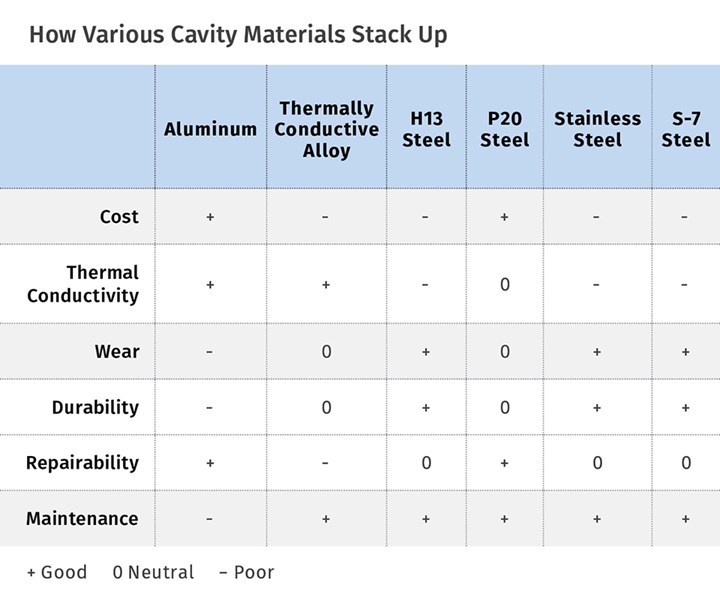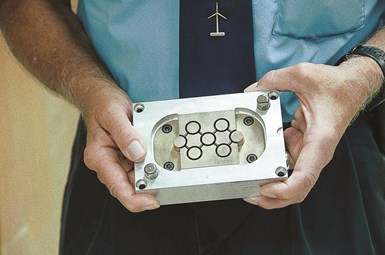How to Select the Right Tool Steel for Mold Cavities
With cavity steel or alloy selection there are many variables that can dictate the best option.
Here, aluminum is used for the mold base because of its superior thermal conductivity, but tool steel is used for the cavity inserts to maximize wear resistance.
With cavity steel or alloy selection there are many variables that can dictate the best option. Things that need to be considered are the material you’ll be molding, cycle-time expectations, part criteria, expected volume, tooling costs, and maintenance. The goal here is not to suggest, recommend, or give preference to any specific steel or alloy, but to offer some guidance you should take into account when making the selection. I’m not an expert on all the steel types used around the world, so there will be some not mentioned—I’m only writing from my personal experience.
Maintenance is the variable I focus on most in the steel-selection process. Most tool makers that build, maintain, and repair production tooling have definite opinions on what they like and don’t like in tool steels. I’ve heard so many varying viewpoints over the years, but I have tried to keep an open mind by taking the big picture into account. So at times I’d be willing to accept added maintenance on the tooling if the payback was faster cycles or lower tool costs. But price should never be the main factor. As I often say, it’s cheaper but costs more.
There are pros and cons to each and every option, so it’s important to know all the angles to understand the long-term cost vs. just the up-front tooling costs. If you need a steel that is wear-resistant, you are looking at a hardened tool steel. This will increase your tooling costs up front, but will reduce your maintenance costs in the long term. But here’s the twist: Hardened steels are less thermally conductive, which can impact cooling time if you don’t put extra focus on the tool design for cooling. If you go with a standard tool steel that will not be hardened, your cost will be lower up front but your long-term maintenance cost will be greater.
Price should never be the main factor. As I often say, it’s cheaper but costs more.
You can also apply a coating or surface treatment to reduce wear, which will still be cheaper than hardened steel but will put you at risk if the tool is damaged. Repairing coatings and surface hardening takes lots of time and money, especially for a part with visual requirements. But the thermal conductivity will be 10-15% greater than with a hardened tool steel. Then there are options in aluminum and alloys with much greater thermal conductivity that can have a big payback in cycle time. Again—pros and cons for each option.

What Are You Molding?
The first thing I take into consideration is the material being molded. With abrasive, glass-filled materials, my focus would be on addressing concerns over wear and erosion unless the expected volume is extremely low. But with the most common glass-filled materials, cooling is more critical than with other materials, and the best steels to address wear have lower thermal conductivity. Carbide inserts are the exception; they have excellent wear properties along with great thermal conductivity, but the costs and lead times to replace these need to be considered.
With corrosive materials such as PVC, stainless steel is a common choice. Using cheaper options will require critical procedures to prevent corrosion. On parts that have very high surface-finish expectation, tool steels that have lens-grade specs should be considered. For molding materials that do not contain abrasives like glass fibers or corrosive ingredients, P-20 steel is the most common choice. But with smaller tools for high-volume production, hardened tool steels are always a good option to prolong the tool life with reduced maintenance. On the other hand, aluminum can be an excellent choice for lower-volume tools to reduce cycle times. But from a maintenance viewpoint, aluminum is not my friend.
Aluminum & Conductive Alloys
A few years back there were a lot of talk and studies about aluminum and its positive impacts on mold-build cost and cycle times, both of which can be significant. But there is always a negative that can offset the positive if all aspects are not considered. What’s more, there are many versions of aluminum, and each has very different properties of toughness and thermal conductivity, so never assume that “aluminum is aluminum.” Do your research.
Aluminum is often used for prototype tooling to keep the costs down, and the production tooling is then built with a more-robust steel. Just keep in mind that the molding results will not be same, and in some cases can be significantly different, depending on the part geometry and size. The main reason is the cooling factor, as aluminum has much greater thermal conductivity. I would not recommend using aluminum on high-volume parts that have visual specs or on tools that have many lifters and slides. Aluminum is very soft and requires extra attention in the design to make sure it is robust enough, and extra care in the press to reduce cavity damage.
Alloys such as MoldMax, Moldstar, or Ampco can have a big impact on cycle time because of their excellent thermal conductivity. They also come in different hardnesses to accommodate the material being molded. But as you go up the hardness scale with these alloys, their thermal conductivity decreases. These materials are much more robust than aluminum, but also are expensive. When used to mold glass-filled materials, these alloys should be coated to prevent erosion, which is an extra cost (along with added maintenance). I typically will use these materials when cavity details are too small or intricate to add water lines. But I always choose forged rather than cast alloys for cavity details because they have more resilience and will not crack or break as easily. The cast versions are better for wear surfaces or components.
The old-school rule of needing 10 points of RC spread for components and cavities is not a fact when you move higher on the RC scale.
The most common, middle-of-the-road tool steel is P-20 or similar, which has 28-30 RC hardness. This steel also comes in a high-hard version (38-40 RC), and in lens grade when high surface-finish requirements are needed. P-20 is the first choice in most cases when using plastics without abrasive additives, but as I mentioned earlier, unless it’s for very low-volume use, you will need to protect the steel against erosion with a coating or surface hardening. This has drawbacks, with which I am very familiar.
For very tight-tolerance and high-volume parts, S-7 is a common choice. It’s a very durable, impact-resistant tool steel that can be hardened up to 56 RC. This steel also is much more stable through the heat-treating process, shrinking or expanding less than H-13 or stainless steel.
In most cases, cavities are hardened to 50-52 RC. S-7 can also be used for slides or lifters and hardened to 54-56 RC. They have excellent wear properties working against the S-7 cavities at 50-52 RC. I’ve seen tools set up like this running every day all week with intricate lifters and never have an issue with wear or galling.
The old-school rule of needing 10 points of RC spread for components and cavities is not a fact when you move higher on the RC scale. On the other hand, running 10 points of spread on the low end is almost a guarantee to create galling issues. I can’t count how many times I have had to deal with galled tools when running P-20 cavities at 28-30 RC and components at 40 RC. The most common error is ordering pre-hardened H-13 lifters at 40 RC and thinking they are good to go. Wrong. All you need to do is have them nitrided after fit and timed and you’re all set for wear and tear.
Stainless steel is commonly used not only for PVC but in medical tooling to provide highly polished cavities. The high end for hardness on stainless steel is 50-52 RC.
H-13 is typically the go-to choice for a tool steel to address wear when running abrasive materials. In most cases, cavities are not hardened above 50 RC to reduce the chances of stress cracks. The typical range is 44-48 RC. I have had a tool with H-13 inserts running 33% glass-filled nylon for 1 million cycles without any wear issues. But I would not recommend this unless you take very careful consideration in the tool design.
With any tool steel that is going to be hardened, you need to focus on some very important issues. I’m fairly confident anyone reading this who has been in the industry has seen cracked cavities or details that have broken off. Typically there are two things that come to mind as contributors to this problem: Either the RC hardness is on the high end with bad steel structure in the design; or, more commonly, there is a sharp edge in the tool. That’s why I always try to make sure all pockets for slides and lifters do not have sharp internal corners in the cavity details. Most CAD models will not have a radius on all edges. So when you are cutting or EDM’ing the details, take this into consideration and leave a radius on all internal corners whenever possible.
ABOUT THE AUTHOR
Randy Kerkstra has been in the plastics industry for more than 30 years, occupied frequently with troubleshooting injection molding. He is currently a tooling manager for a large, multi-plant molding and manufacturing company. Contact: kbmoldingsolutions@gmail.com.
Related Content
Why Shoulder Bolts Are Too Important to Ignore (Part 1)
These humble but essential fasteners used in injection molds are known by various names and used for a number of purposes.
Read MoreFundamentals of Polyethylene – Part 6: PE Performance
Don’t assume you know everything there is to know about PE because it’s been around so long. Here is yet another example of how the performance of PE is influenced by molecular weight and density.
Read MoreThe Effects of Stress on Polymers
Previously we have discussed the effects of temperature and time on the long-term behavior of polymers. Now let's take a look at stress.
Read MoreInjection Molding: Focus on these Seven Areas to Set a Preventive Maintenance Schedule
Performing fundamental maintenance inspections frequently assures press longevity and process stability. Here’s a checklist to help you stay on top of seven key systems.
Read MoreRead Next
See Recyclers Close the Loop on Trade Show Production Scrap at NPE2024
A collaboration between show organizer PLASTICS, recycler CPR and size reduction experts WEIMA and Conair recovered and recycled all production scrap at NPE2024.
Read MoreFor PLASTICS' CEO Seaholm, NPE to Shine Light on Sustainability Successes
With advocacy, communication and sustainability as three main pillars, Seaholm leads a trade association to NPE that ‘is more active today than we have ever been.’
Read MoreMaking the Circular Economy a Reality
Driven by brand owner demands and new worldwide legislation, the entire supply chain is working toward the shift to circularity, with some evidence the circular economy has already begun.
Read More






















